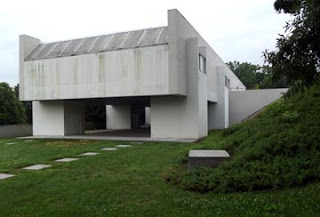As I returned home from installing my marble sculpture in Dalton, Georgia, I decided to take a break from the bumpy ride in the large rental truck and investigate the Old Stone Fort Archaeological Park near Manchester, Tennessee. I'm happy that I did - it's a very special place.
This is an aerial photograph that is on display in the museum; it really helps to get a sense of the site. It is approximately 50 acres that is almost completely surrounded by 2 forks of the Duck River.
On the upriver end of the peninsula, the rivers almost meet. This creates a narrow entryway onto the site. These are 2 small earthen mounds that flank either side of the entrance.
This is the ground view of the open field that is surrounded by the low earthen remains of walls that encircle this huge site.
A 1-1/4 mile path follows the walls around the field. It's a very pleasant walk through the woods, looking over the cliffs to the rivers and listening to the roar of water as it goes over cascades and numerous waterfalls.
This is a sign that is at the head of the trail. It claims that the earthen cap has spilled over 2 internal stone cores in the last 1,500 years that it "has been out of use" and that this site was created by Woodland Indians over the course of 400 years. ...that's the "official" theory...

The trail crossed over the walls at this point, and they built a wooden stair to reduce wear on the wall remains. This is what most of the walls look like today. More extensive research indicates that the walls were made of an inside and outside layer of dry laid stone with earth fill. To my knowledge, this type of construction was not employed by American Indians...but it was used extensively in the "Old World"; particularly in Wales and Ireland. The walls may have been quite high and thick at one time. The stone was taken away in the late 1800's to make roads and the earth filling was left behind. The lower stones (inside the dirt pile) were left because it wasn't worth digging them out as the upper stones (holding the dirt fill) were removed. So...let's take a closer look at the 2 mounds at the entrance...would excavation or ground-imaging radar reveal the foundations of guard towers; are the mounds the earth fill left after stealing the stone casing?

This sign, near the end of the trail close to the museum, explains how the area was used heavily for industry in the 1800's.
This is a close-up of the photo of one of the mills that used the waterfalls for power.
100 years later, this is all that's left of that complex of buildings in the photograph. You can see the problem that faces archaeology - without the photo could you ever imagine what that mill looked like by examining this tiny section of stone wall? So, what did the Old Stone Fort look like originally - and who actually built it? My guess is that the true story of this place is much more extensive and stranger than the accepted academic theory.
I'll end this post with a picture of the last waterfall on the trail ...well, actually a dam built in 1963, two years before it was turned into a state park. The Old Stone Fort is a magical and mysterious place. I highly recommend a stop, if you are traveling on I-24 through Tennessee. I plan to return when I get another chance.























.jpg)
.jpg)










